Bourne, Lincolnshire
Up to 1834
A parliamentary report of 1777 recorded parish workhouses in operation in Bourn (for up to 44 inmates) and Deeping St James (12 inmates).
In 1813, a parish workhouse was erected at Folkingham (or Falkingham as it was sometimes spelt) on West Street.

Former parish workhouse, Folkingham, 2003.
© Peter Higginbotham.
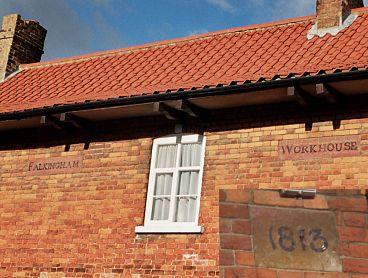
Former parish workhouse, Folkingham, 2003.
© Peter Higginbotham.
Deeping St James erected a parish workhouse in 1815. The building was later used as an elementary school and was rebuilt in 1899.
Haconby had a workhouse on Chapel Street, now didvided into three cottages.
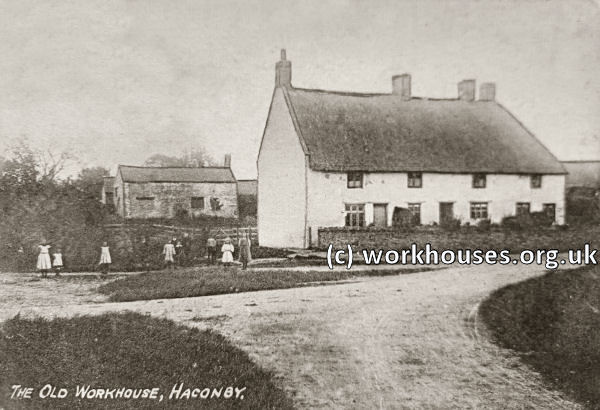
Former parish workhouse, Haconby.
© Peter Higginbotham.
After 1834
Bourne [sometimes spelt Bourn] Poor Law Union was formed on 25th November 1835. Its operation was overseen by an elected Board of Guardians, 44 in number, representing its 37 constituent parishes as listed below (figures in brackets indicate numbers of Guardians if more than one):
County of Lincoln: Aslackby, Aunby, Baston, Billingborough, Birthorpe, Bourne (5), Bulby cum Howthorpe, Bytham Castle, Little Bytham, Careby, Carlby, Corby, Creeton, Counthorpe, Deeping St James (3), Market Deeping (2), Dowsby, Dunsby, Edenham, Folkingham, Haconby, Holywell, Horbling, Irnham, Kirkby Underwood, Laughton, Langtoff, Manthorpe, Morton, Pointon, Rippingale, Swayfield, Swinestead, Semperingham, Thurlby, Toft-cum-Lound, Witham-on-the-Hill.
The population falling within the Union at the 1831 census had been 17,174 with parishes ranging in size from Semperingham (population 27) to Bourne itself (2,589). The average annual poor-rate expenditure for the period 1833-35 had been £8,506 or 9s.11d. per head.
The new workhouse was built in 1836-7 at the end of Union Road (now St Peter's Road) at the west of Bourne. The architect was Bryan Browning who was also responsible for workhouses in Spalding and Stamford. It was designed to accommodate 300 people and the Poor Law Commissioners authorized an expenditure of £5,350 for its construction.
The workhouse location and layout can be seen on the 1903 map below.

Bourne workhouse site, 1903.
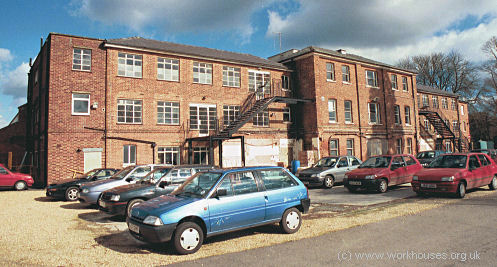
Bourne south range from the south-west, 2001.
© Peter Higginbotham.

Bourne eastern yard from the east, 2001.
© Peter Higginbotham.
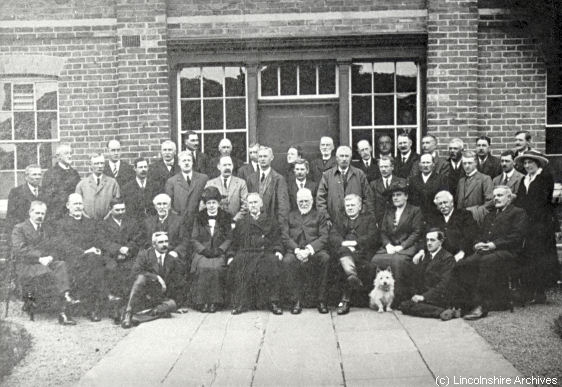
Bourne Board of Guardians (and dog!), c.1930.
© Lincolnshire Archives.
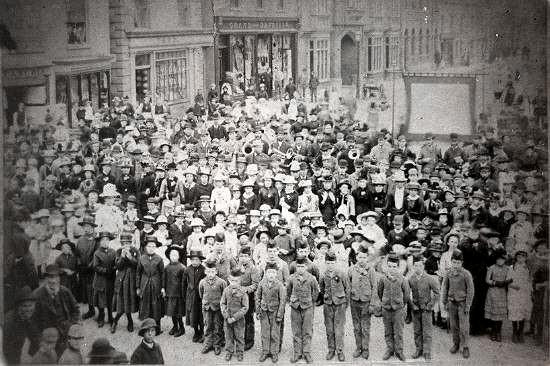
Workhouse boys and girls on parade in the town market place at a public gathering for an unidentified special occasion c.1900.
Photograph reproduced from A Portrait of Bourne © REX NEEDLE..
After 1930, the workhouse was officially known as Bourne Public Assistance Institution and was also known as Wellhead (or Well Head) House. In the 1930s, the institution became St Peter's Hospital for the mentally handicapped and the main building was remodelled. The hospital closed in the 1980s and then stood empty for some years.
The buildings later became part of a printing company's premises but were demolished in 2001 shortly after these pictures were taken.
Mike Darlington has discovered some family connections with Bourne workhouse which he has kindly allowed to be included here. Mike writes:
My maternal grandmother, my mother (now 90 years old) and her late brother were taken into care when my mother and uncle were 10 and 7 respectively, following the death of their father and the incapability of their mother (my maternal grandmother) to look after them.
There were three floors to the building. On the third floor were the labour ward, rest ward and a nursery ward for maternity cases. There was no electricity in the workhouse, only gas. Sterilized boiling water had to be carried in kettles from the kitchen up three flights of stairs
A few years ago I asked my mother to write down a few of her reminiscences about life in the Workhouse. She found the experience rather painful because of the memories it brought back. Food was monotonous. Tea-time was the same as breakfast, 3oz bread for the children 4ozs for adults. Jam once a week on a Sunday. Their highlight of the year was Christmas day when the Guardians, Clerk to the Town Council Aldermen and Ladies came to visit. The workhouse children were escorted daily by the porter to the school in the town.
My mother's mother died in Wellhead house in March 1925 and was buried in a pauper's grave in Billingborough churchyard where my grandfather had previously been buried. By this time my mother's brother was 10 years old and the Guardians decided he needed a better climate. The result was that he was separated from my mother and shipped off via Dr Barnardo's to a new life in Canada where he would be 'apprenticed' to a farmer.
How do I come to have matron Hancock's retirement tea set? Shortly before her retirement matron Hancock decided to informally 'adopt' my mother. I gather she was looking after her own welfare as well, looking to be looked after in her old age. She was rather upset when mother married my father in 1935. Until her death in her 90's she was always known to me as Gran Hancock.
Staff
Inmates
Records
Note: many repositories impose a closure period of up to 100 years for records identifying individuals. Before travelling a long distance, always check that the records you want to consult will be available.
- Lincolnshire Archives, St. Rumbold Street, Lincoln LN2 5AB. Holdings include: Guardians' minute books (1837-1930 with gaps); Admissions and discharges (1836-1930, with gaps); Births (1866-1930); Deaths (1866-1936); etc.
Bibliography
- Higginbotham, Peter The Workhouse Encyclopedia (2014, The History Press)
Links
- None.
Unless otherwise indicated, this page () is copyright Peter Higginbotham. Contents may not be reproduced without permission.


